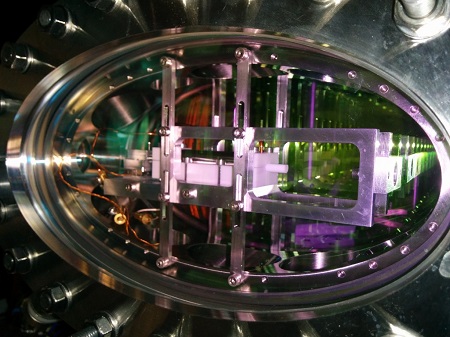MAINZ, Germany, Oct. 21, 2020 — Researchers at Johannes Gutenberg University Mainz (JGU) successfully transported light stored in a quantum memory over a distance of 1.2 mm. The technology, once refined, could have implications for quantum memory storage.
To achieve high-level storage efficiency and to extend the lifetime of the stored light, the researchers used ultracold rubidium-87 atoms as a storage medium. The light is stored via an electronically induced transparency process, in which the electric field of the incoming light is coherently transformed into an excitation of the storage medium, which, in this case, is the rubidium atoms, Patrick Windpassinger, associate professor of physics at JGU, told Photonics Media.

For the experiment, rubidium-87 atoms are pre-cooled and subsequently transported to the main test area: a custom-made vacuum chamber. There they are cooled to single-digit microkelvin temperatures. Courtesy of Patrick Windpassinger.
“Usually when you have resonant light, the respective medium absorbs the light,” Windpassinger said. “By adding a second beam, the so-called control beam, one can change the properties of the medium such that it becomes transparent for the light field to be stored. At the same time, the velocity of the light is reduced inside the medium.”
Due to the reduced velocity, the pulse is compressed and becomes able to enter the medium. Once it has entered, the control beam is shut off, trapping the light. The control field can be turned back on to take the light out again.
The research builds on previous work in which ensembles of cold atoms were transported on an “optical conveyer” produced by two laser beams. The method allowed a relatively large number of atoms to be transported and positioned with a high degree of accuracy without significant loss of atoms and without the atoms being unintentionally heated.
The researchers used that technique to transport the cloud of cold rubidium-87 atoms containing light over a distance of 1.2 mm.
“This is very interesting, not only for physics in general, but also for quantum communication, because light is not very easy to ‘capture,’ and if you want to transport it elsewhere in a controlled manner, it usually ends up being lost,” Windpassinger said.
For potential future applications, Windpassinger envisions a shift register or a race track memory for light.
“So one would have an array or lattice of atoms and each site would be a storage cell, very much like in a hard drive or a tape. Then you could have one place, where you write and read the storage cells (like the read/write head of a hard drive or a tape recorder) and just move the respective site of the lattice there,” Windpassinger told Photonics Media. That could then be part of a quantum computer or a node in a communication network and allow for multiplexing, for example.
Scaling up to a larger number of storage cells is necessary before the development can support a reliable technique for quantum applications, and the storage time would need to be significantly increased. Currently, electronically induced transparency techniques only allow light to be stored for a matter of seconds.
“We are more interested in, for example, storing two light pulses next to each other and then merging the two storage cells and see if we can make light interact in a controlled way,” Windpassinger said.
The research was published in Physical Review Letters (www.doi.org/10.1103/PhysRevLett.125.150501).